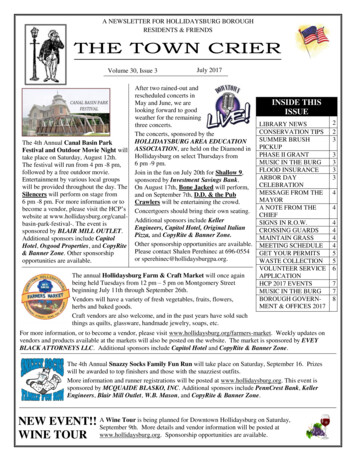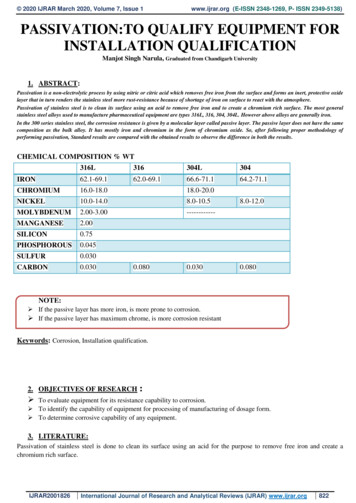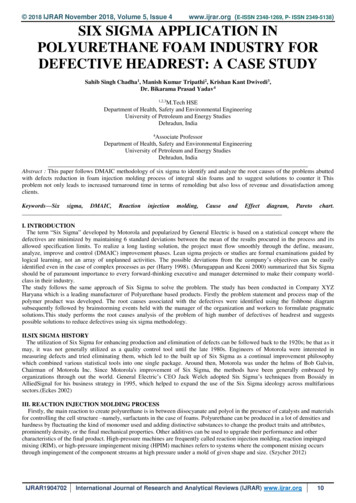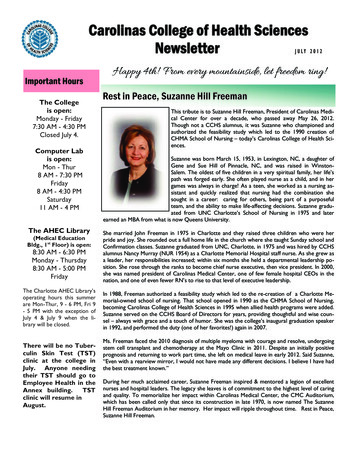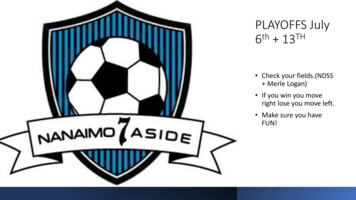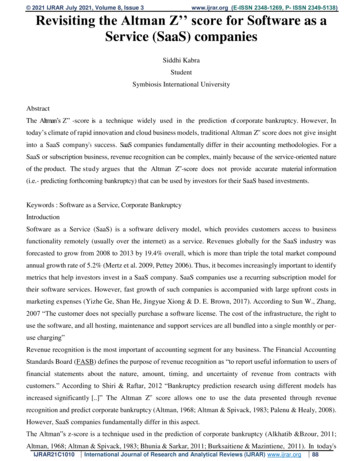
Transcription
2021 IJRAR July 2021, Volume 8, Issue 3www.ijrar.org (E-ISSN 2348-1269, P- ISSN 2349-5138)Revisiting the Altman Z’’ score for Software as aService (SaaS) companiesSiddhi KabraStudentSymbiosis International UniversityAbstractThe Altman’s Z” -score is a technique widely used in the prediction of corporate bankruptcy. However, Intoday’s climate of rapid innovation and cloud business models, traditional Altman Z‟‟ score does not give insightinto a SaaS company’s success. SaaS companies fundamentally differ in their accounting methodologies. For aSaaS or subscription business, revenue recognition can be complex, mainly because of the service-oriented natureof the product. The study argues that the Altman Z‟‟-score does not provide accurate material information(i.e.- predicting forthcoming bankruptcy) that can be used by investors for their SaaS based investments.Keywords : Software as a Service, Corporate BankruptcyIntroductionSoftware as a Service (SaaS) is a software delivery model, which provides customers access to businessfunctionality remotely (usually over the internet) as a service. Revenues globally for the SaaS industry wasforecasted to grow from 2008 to 2013 by 19.4% overall, which is more than triple the total market compoundannual growth rate of 5.2% (Mertz et al. 2009, Pettey 2006). Thus, it becomes increasingly important to identifymetrics that help investors invest in a SaaS company. SaaS companies use a recurring subscription model fortheir software services. However, fast growth of such companies is accompanied with large upfront costs inmarketing expenses (Yizhe Ge, Shan He, Jingyue Xiong & D. E. Brown, 2017). According to Sun W., Zhang,2007 “The customer does not specially purchase a software license. The cost of the infrastructure, the right touse the software, and all hosting, maintenance and support services are all bundled into a single monthly or peruse charging”Revenue recognition is the most important of accounting segment for any business. The Financial AccountingStandards Board (FASB) defines the purpose of revenue recognition as “to report useful information to users offinancial statements about the nature, amount, timing, and uncertainty of revenue from contracts withcustomers.” According to Shiri & Raftar, 2012 “Bankruptcy prediction research using different models hasincreased significantly [.]” The Altman Z‟‟ score allows one to use the data presented through revenuerecognition and predict corporate bankruptcy (Altman, 1968; Altman & Spivack, 1983; Palenu & Healy, 2008).However, SaaS companies fundamentally differ in this aspect.The Altman‟s z-score is a technique used in the prediction of corporate bankruptcy (Alkhatib &Bzour, 2011;Altman, 1968; Altman & Spivack, 1983; Bhunia & Sarkar, 2011; Burksaitiene & Mazintiene, 2011). In today‟sIJRAR21C1010International Journal of Research and Analytical Reviews (IJRAR) www.ijrar.org88
2021 IJRAR July 2021, Volume 8, Issue 3www.ijrar.org (E-ISSN 2348-1269, P- ISSN 2349-5138)climate of innovation with cloud business models, traditional Altman Z‟‟ score does not give insight into aSaaS company‟s success.Objective of the studyThe objective of this study is to highlight the inability of the Altman Z’’ score to predict corporate bankruptcyfor SaaS companies.Literature reviewIndustry research in the SaaS domain is commonly presented as web content, published by a practitioner orpractitioner organization. While recent and active, it is rarely peer-reviewed. Any insights into the SaaS industryis typically written from a practitioner perspective, with a focus on tactical case studies (Sukow & Grant, 2013).The Z-Score exists in three forms. The original version developed was for predicting bankruptcy potential inpublicly held manufacturing businesses. According to Hauschild, 2013 “The Z-Score formulation by EdwardAltman in 1968 successfully predicted bankruptcy with 90% accuracy within one year of filing and 80%accuracy two years in advance. Dr. Altman then created two new forms of the bankruptcy prediction formula.These were identified as Z‟ (Z prime) and Z” (Z double prime) although they are also referred to as Z (A) and Z(B). Z‟ was developed for privately-held industrial companies and Z” developed for non- manufacturing andservice companies” (Hauschild, 2013).The current score to predict the bankruptcy for SaaS companies (in developed and emerging markets) is:Z‟‟ 3.25 (6.56 x A) (3.26 x B) (6.72 x C) (1.05 x D) whereWhere, A Current Assets – Current Liabilities / Total Assets B Retained Earnings / Total AssetsC Earnings before interest and taxes / Total Assets D Book Value of Equity / Total LiabilitiesTraditional financial data is used as variables in the Altman Z score. (Altman, 1968; Altman & Spivack, 1983;Palenu & Healy, 2008).These variables include sales, asset turnover, leverage, short-term leverage, andprofitability analysis (Altman, 1968; Altman & Spivack, 1983; Bhunia & Sarkar, 2011; Burksaitiene &Mazintiene, 2011).SaaS companies fundamentally differ in their accounting methodologies. Revenue recognition can be complexfor a SaaS company because of its service-oriented nature. While the customers may pay a lump sum upfront fora year‟s worth of usage, the business do not categorize the entire amount of cash as revenue right away. Forexample – If a SaaS company books a customer on a annual plan of 10,000, then the company recognizes 833.33 each month, or 27.40 each day.Deferred subscription fees which are generally carried over in the balance sheet for the purpose of revenuerecognition make up an integral part of the liabilities of a SaaS company. Smale (2016) further elaborates that“a large amount of intrinsic corporate value lies within intangible or qualitative measures of the firm. Examplesof this include stability of the earning power, owner-specific business relationships, business traffic attributableto search engines and their algorithms, level of competition within the business niche, and type of customersIJRAR21C1010International Journal of Research and Analytical Reviews (IJRAR) www.ijrar.org89
2021 IJRAR July 2021, Volume 8, Issue 3www.ijrar.org (E-ISSN 2348-1269, P- ISSN 2349-5138)targeted by the company.”Applying the traditional Altman Z‟‟ score for some of the most successful SaaS based companies does notindicate any forthcoming bankruptcy. Mark Verbeck, former CEO of Coupa (a Business Spend Managementplatform) illustrates using the data for successful SaaS companies as calculated for the year prior to each of theirIPOs based on their public filings on sec.gov:salesforce.com22 (6.26) (1.66) 0.15 (4.30)3.25NetSuite(4.39) (12.84) (3.12) (17.63)(0.53) 3.25Marketo2.35 (3.39) (2.90) 1.29 0.603.25(0.27) (6.37) (3.74) (7.32)(0.19) 3.25WorkdayAccording to Dr. Altman “A Z‟‟ score of greater than 2.6 means that the entity being measured is safe frombankruptcy. A score of less than 1.1 means that a business is at considerable risk of going into bankruptcy, whilescores in between should be considered a red flag for possible problems.” The above scores indicate the nonsustainability of successful SaaS companies. Thus, the Altman Z‟‟ score is not indicative of the sustainability ofSaaS based companies.Thus, the usage of Altman Z‟‟ score for predicting the bankruptcy of SaaS companies is not justified. Therevisited Altman Z‟‟ score does not take into account aspects that make a SaaS company fundamentally fromother companies.Discussion (Variable selection)In the traditional definition, enterprise software is software an organization buys and installs on its servers. SaaSsoftware is software that is “rented” and is hosted “in the cloud” and accessed via the internet. According toHaeger, Douglas & Nisby, 2013 “For a company with a subscription based business model two key customermetrics are commonly used to measure the company‟s performance. These metrics are Churn and CustomerAcquisition Cost (CAC) and they are related to the company‟s customer base (i.e - the group of customers orconsumers that abusiness serves)” and sales. At the early stage when software is still in beta, it may be riddledwith bugs and certainly far from user-friendly. The ones who choose to use the software in its rudimentaryversion tend to be tech optimists.IJRAR21C1010International Journal of Research and Analytical Reviews (IJRAR) www.ijrar.org90
2021 IJRAR July 2021, Volume 8, Issue 3www.ijrar.org (E-ISSN 2348-1269, P- ISSN 2349-5138)According to The theory of diffusion (Rogers, 2006), this group comprises of innovators and early adopters.The software is continually proven due to the feedback provided by the members of this group. Thus, innovatorsand early adopters do not prefer using the software for long periods of time. As a result, a high churn rate isexpected during the minimum viable product stage of software.The churn rate increasing rapidly should be coupled with a rising customer acquisition cost. The selection ofthese measurements (typical of any SaaS start up) (Desjardins, 2017 & Gorski, 2016) thus, conveys a great dealof information. According to Sukow & Grant “subscriber’s behavior changes over the life cycle of thesubscription, using a continuous churn rate over the life the subscription will result in inaccurate subscriptionanalysis.DiscussionAs such, some important variables we may focus on while investing a SaaS company can be:Customer Churn Rate – Churn rate refers to the loss of subscribers (or clients). Acording to J York, 2010 “Churn impedes the growth of a SaaS-based business. It also determines the maximum number of users abusiness can support in a steady stat” In general, churn is the number or percentage of subscribers thatdiscontinue their subscription to a SaaS service.Logically, for a company to expand its clients base, the number of new customers must exceed number of lostcustomers. In an article at SaaS Capital, Todd Gardner and team calculate that a 1% difference in churn can havea 12% impact on valuation in five years. This can happen as people leaving decrease the potential value of arecurring revenue stream.Customer Acquisition Cost- According to SaaS Metrics, “Customer Acquisition Cost refers to the resources thata business must allocate (financial or otherwise) in order to acquire an additional customer. It includes everyeffort required to introduce an organisation‟s products and services to its prospective customers, and thenconvince them to buy and become active customers. Some common sales & marketing expenses are: paidadvertisement, sales and marketing staff salaries, CRM and marketing automation software licenses, events,sponsorships, gifts to customers, content production, social media and web site maintenance. CAC plays a majorrole in calculating the value of the customer to the company and the resulting return on investment (ROI) ofacquisition.”How much of a company‟s resources can be spent profitably on a customer is a question that customer valuationhelps companies decide. In general terms, it helps to decide the worth of the customer to the company.Customer Lifetime Value: According to Chargebee, CLTV (Customer LifeTime Value) refers to the amount ofrevenues that the company expects to generate from a customer during the period over which their service willbe of value.According to Cohen & Neubert “Every additional user or every additional activity a user performs (e.g. increaseof required storage or download volume), immediately result in higher sales revenues” (Cohen & Neubert,2018). Companies spend more in acquiring customers than the amount they spend on retaining current customersin the SaaS industry. This translated into a problem of customer retention. Often, SaaS companies spend mostIJRAR21C1010International Journal of Research and Analytical Reviews (IJRAR) www.ijrar.org91
2021 IJRAR July 2021, Volume 8, Issue 3www.ijrar.org (E-ISSN 2348-1269, P- ISSN 2349-5138)of their resources on growth through new customers while failing to keep the existing customers happy. Thus,In any SaaS business model the goal has to be to minimize CAC while maximizing LTV.Net New Monthly Recurring Revenue (MRR) - Recurring revenue from the existing customer is what makesSaaS fundamentally different from other enterprises. It is noted as the “Lifeblood of SaaS based companies.”According to Klipfolio, “Net monthly recurring revenue refers to the monthly value of newly acquired accountsto an organisation‟s sales system and monthly added value to current accounts, minus the value lost from closedor reduced accounts.” The sustainability & success of a business depends on how consistently it brings inrevenue every month. The SaaS is based on a subscription model, thus revenues and profits trickle in slowly.Thus, MRR can act as a baseline to measure success of a SaaS company.Because SaaS companies have to invest upfront in marketing expenses to acquire customers, and only getpayments from those customers over a delayed period of time, they face a cash flow problem initially. Theupfront costs in setting up the infrastructure are easier to maintain as there is a continuous flow of predictablerevenue indicated through MRR.The significance of this study lies in identifying the unviability of the Altman Z‟‟ score to indicate thesustainability of SaaS companies. Further, this study highlights the unique factors that distinguish a SaaS basedcompany from a non-SaaS company.Further scope of study lies in developing a score specifically for SaaScompanies with the factors highlightedIt is important to note a few problems with developing a score specifically for SaaS based companies.Subscription-based business models are driven by four factors: (1) average revenue per user (ARPU), (2) costper acquisition, (3) cost of service, and (4) churn. Consequently, the majority of companies identified in thestudy discuss a subscription-based business model provide data for at least one of these customer metrics(Bonacchi, Massimiliano, Kolev & Lev, 2011). However, there is a lack of uniformity in the reported metricspotentially due to competitive pressures or voluntary nature of disclosure.IJRAR21C1010International Journal of Research and Analytical Reviews (IJRAR) www.ijrar.org92
2021 IJRAR July 2021, Volume 8, Issue 3www.ijrar.org (E-ISSN 2348-1269, P- ISSN 2349-5138)ReferencesAlkhatib, K., & Bzour, A. (2011). Predicting corporate bankruptcy of Jordanian listed companies: UsingAltman and Kida models. International Journal of Business & Management,6(3), 208-215Altman, E. I. (1968). Financial ratios, discriminant analysis and prediction of Corporate bankruptcy.Journal of Finance, 23(4), 589-609Altman, E. I., & Spivack, J. (1983). Predicting bankruptcy: The value line relative financial strengthsystem vs. the zeta bankruptcy classification approach. Financial Analysts Journal,39(6), 60-67Auvinen, Riku. "Identifying relevant metrics as performance indicators in a B2B SaaS company: CaseSmartly. io." (2017).Bhunia, A., & Sarkar, R. (2011). A study of financial distress based on MDA. Journal of ManagementResearch, 3(2), 1-11Bonacchi, Massimiliano, Kalin Kolev, and Baruch Lev. The analysis and valuation of subscriptionbased enterprises. working paper, Yale University, 2011.Burksaitiene, D., & Mazintiene, A. (2011). The role of bankruptcy forecasting in the Companymanagement. Economics & Management, 16137-143Cohen, Benjamin, and Michael Neubert. "Corporate Valuation of SaaS Companies–A Case Study ofSalesforce. com." In 11th Annual Conference of the EuroMed Academy of Business, pp. 357-371. 2018.Dearing JW, Meyer G. Revisiting diffusion theory. In: Singhal A,DearingJW, editors.Communication of innovations: A journey with Ev Rogers. Thousand Oaks, CA: Sage; 2006.Desjardins, J.: 34 Startup metrics for tech entrepreneurs. founder-know/ (2017)Edward I. Altman (2000) Predicting Financial Distress of Companies: Revisiting the Z‟‟ score and Zeta Models, NYU SternGorski, T.: 21 Most important SaaS startup metrics. as-startup-metrics (2016)Haeger, Douglas, and Gabriella Nilsby. "Improving customer metrics in a subscription based business.A study of a company within the pre-packed grocery bag industry." Master's thesis, 2013.Hauschild, Dan. "Altman Z-Score: Not just for bankruptcy." From Z-score to" Green Zone"survivability: AMPros Corporation (2013).J. York, “SaaS Metrics Guide to SaaS Financial Performance,” 2010. financial-performanceKemell, K. K., Wang, X., Nguyen-Duc, A., Grendus, J., Tuunanen, T., & Abrahamsson, P. (2019). 100 Metrics for Software Startups-A Multi-Vocal Literature Review. arXiv preprint arXiv:1901.04819.Mark Verbeck, 2014.: Predicting the financial viability of SaaS vendors. nancial-viability-saas-vendors/Mertz, S.A., Eschinger, C., Eid, T., Huang, H.H., Pang, C., and Pring, B. 2009. "Market Trends:IJRAR21C1010International Journal of Research and Analytical Reviews (IJRAR) www.ijrar.org93
2021 IJRAR July 2021, Volume 8, Issue 3www.ijrar.org (E-ISSN 2348-1269, P- ISSN 2349-5138)Software as a Service, Worldwide, 2008-2013," Gartner.N. Latka, World’s largest database of SaaS Metrics, r-saas-metrics/Narang, Pallavi, J. S. Hudiara, and Sawtantar S. Khurmi. "Bring Into Play the Software Metrics inSAAS-A Cloud Computing Prospective." International Journal of Innovative Research in Science,Engineering and Technology 3, no. 11 (2014).Palenu, K. G. and Healy, P. M. (2008). Business Analysis & Valuation:Using Financial Statements.Mason, HO: Thomson/South-WesternPettey, C. 2006. "Gartner Says 25 Percent of New Business Software Will Be Delivered as Software asa Service by 2011." Stamford, Conn.: GartnerShiri, M., Amini, M., & Raftar, M. (2012). Data mining techniques and predicting corporate financialdistress. Interdisciplinary Journal of Contemporary Research in Business, 3(12), 61- 68.Smale, T. (2016, July 6). SaaS valuations: How to value a SaaS business in 2017. FE International.[ONLINE] Available at to-value-saas-business/.Sukow and R. Grant 2013, "Forecasting and the Role of Churn in Software-as-a-Service BusinessModels," iBusiness, Vol. 5 No. 1A, 2013, pp. 49-57.Sun, W., Zhang, K., Chen, S., Zhang, X., Liang, H.: Software as a Service: An Integration Perspective.In: Krämer, B.J., Lin, K.-J., Narasimhan, P. (eds.) ICSOC 2007. LNCS, vol. 4749, pp. 558–569.Springer, Heidelberg (2007)Yizhe Ge, Shan He, Jingyue Xiong and D. E. Brown, "Customer churn analysis for a software- as-aservice company," 2017 Systems and Information Engineering Design Symposium (SIEDS),Charlottesville, VA, 2017, pp. 106-111IJRAR21C1010International Journal of Research and Analytical Reviews (IJRAR) www.ijrar.org94
Marketo 2.35 (3.39) (2.90) 1.29 3.25 0.60 Workday (0.27) (6.37) (3.74) (0.19) 3.25 (7.32) According to Dr. Altman "A Z‟‟ score of greater than 2.6 means that the entity being measured is safe from bankruptcy. A score of less than 1.1 means that a business is at considerable risk of going into bankruptcy, while


